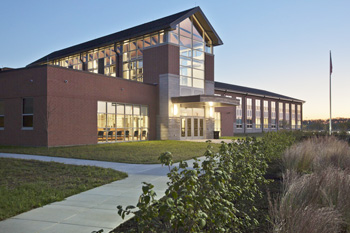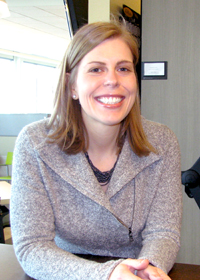PODCAST: Q&A with Allison McKenzie
 Allison McKenzie, leading design architect and director of sustainability for Cincinnati-based architecture firm SHP Leading Design, will present at NeoCon for the third time June 10-12 in Chicago. This year she will give a presentation on selecting quality green products with LEED design in mind, with an emphasis on green design in schools. Green Building News spoke with McKenzie about her upcoming presentation and the future of green building.
Allison McKenzie, leading design architect and director of sustainability for Cincinnati-based architecture firm SHP Leading Design, will present at NeoCon for the third time June 10-12 in Chicago. This year she will give a presentation on selecting quality green products with LEED design in mind, with an emphasis on green design in schools. Green Building News spoke with McKenzie about her upcoming presentation and the future of green building.
Q: What are some of the major trends you see forming in the green building industry right now?
McKenzie: The aspect of lifecycle analysis is an up-and-coming trend. You’re seeing more and more manufacturers disclosing product information. One example is Interface carpets, which has really been leading the way in really disclosing all of the impacts from their product and what they’re putting out from start to finish — not just while you’re using the products, but what happens with the manufacturing of it and what you do with the product when the lifecycle is over. The other really big thing I keep seeing is a focus on the appreciation of nature and what we can learn from nature when it comes to design.
Q: A lot of builders seem to be backing off on LEED certification. Would you agree with this, and what do you think it means for the future of green building?
McKenzie: I think there’s definitely some hesitancy — right now especially because we’re getting ready to transition to a new version of LEED. What was going to be LEED 2012 is now LEED v4, and there’s a lot of fear about the new rating system. Some people are just not really sure if they’re going to be able to comply with the new information. There’s also a growing undertone of displeasure from special interest groups. The North Carolina issue, for example, is being led by the forestry industry and deals with the controversy of certified wood.
I think just as with any other rating system or concept that’s gaining in popularity, it’s having more and more exposure to more groups. As people learn more about LEED, there are more people that now know about it that find some reason to object to it. I do think that as the rating system gains mass appeal, it’s obviously going to be a much more public thing. I think these issues will keep arising especially with the uncertainty in regards to the changes of the LEED rating system. Until that’s answered, I think it’s something we’ll keep seeing again and again.
Q: With your expertise regarding green design in schools, what is your response to the USGBC’s State of America’s Schools report?
 McKenzie: A lot of that report is targeted at just stressing the importance of how learning environments really do impact how our students are being educated. That’s an opinion that my firm and I share — that where you learn really does make a difference and does matter — and a lot of students are unfortunately learning in undesirable locations.
McKenzie: A lot of that report is targeted at just stressing the importance of how learning environments really do impact how our students are being educated. That’s an opinion that my firm and I share — that where you learn really does make a difference and does matter — and a lot of students are unfortunately learning in undesirable locations.
I have been fortunate to be located in Ohio were we have a state mandate to achieve LEED Silver certification on all publicly funded schools, so the report doesn’t necessarily reflect the current environment in the location that I’m doing business on a day-to-day basis but certainly there are significant issues with schools around the countries on things that good sustainable design could certainly help address.
Q: What is the first step in building healthier schools?
McKenzie: I think that it’s going to vary a little bit from location to location because obviously strategies and priorities are going to be a little bit different, but what we’ve really seen is how important indoor environmental air quality is in our student educational environments. We have a project that we’ve been tracking very closely that has great use of daylight, rooftop monitors, lots of glass, good ventilation and other typical practices. We’re seeing that students are experiencing 30 percent less disciplinary actions and teachers are taking 30 percent less sick days. Simple things having to do with indoor environmental quality and just making the school a good place to be is turning out to make a huge difference in student performance and well being in the spaces.
Q: What do you predict is on the horizon for the green building industry?
McKenzie: We’re at an interesting time where green building codes or proposed model codes that could be adopted by various jurisdictions are starting to keep pace with some of those various rating systems like LEED. It’s going to be interesting as we see what becomes expected as far as codes go on the sustainable design front and how other projects are really setting themselves apart as leaders in sustainable design. LEED is going to get much more stringent with this next version, which I think it has to in order to keep ahead of things. But we’re also starting to see competitors like the Living Building Challenge that really are pushing the envelope of what we can do in terms of sustainable design. I think in the very near future, because of codes, all new buildings will be relatively sustainable, and seeing how many firms and how many projects are really committed to pushing above and beyond those requirements is going to be interesting.
In the below podcast, McKenzie shared a few tips from her upcoming presentation on what to look for during the product selection process to avoid greenwashing and purchase a truly sustainable product.
